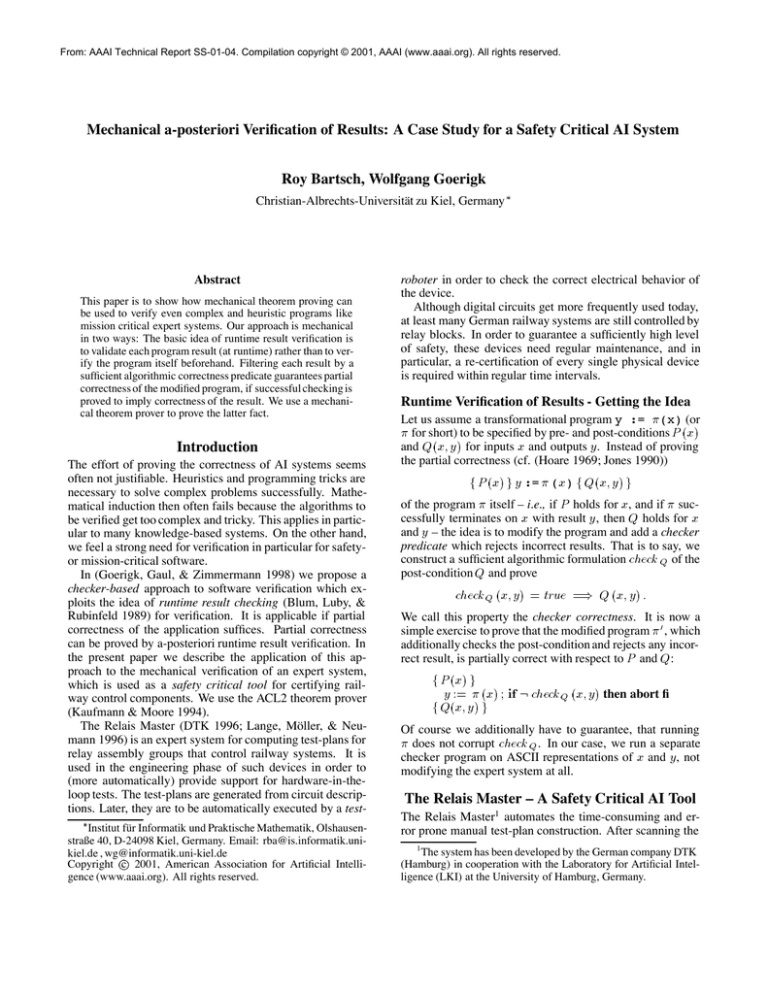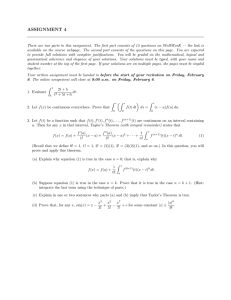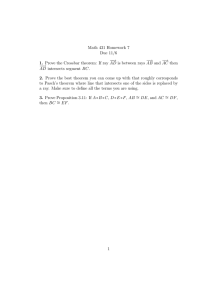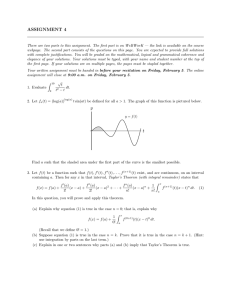
From: AAAI Technical Report SS-01-04. Compilation copyright © 2001, AAAI (www.aaai.org). All rights reserved.
Mechanical a-posteriori Verification of Results: A Case Study for a Safety Critical AI System
Roy Bartsch, Wolfgang Goerigk
Christian-Albrechts-Universität zu Kiel, Germany £
Abstract
This paper is to show how mechanical theorem proving can
be used to verify even complex and heuristic programs like
mission critical expert systems. Our approach is mechanical
in two ways: The basic idea of runtime result verification is
to validate each program result (at runtime) rather than to verify the program itself beforehand. Filtering each result by a
sufficient algorithmic correctness predicate guarantees partial
correctness of the modified program, if successful checking is
proved to imply correctness of the result. We use a mechanical theorem prover to prove the latter fact.
Introduction
The effort of proving the correctness of AI systems seems
often not justifiable. Heuristics and programming tricks are
necessary to solve complex problems successfully. Mathematical induction then often fails because the algorithms to
be verified get too complex and tricky. This applies in particular to many knowledge-based systems. On the other hand,
we feel a strong need for verification in particular for safetyor mission-critical software.
In (Goerigk, Gaul, & Zimmermann 1998) we propose a
checker-based approach to software verification which exploits the idea of runtime result checking (Blum, Luby, &
Rubinfeld 1989) for verification. It is applicable if partial
correctness of the application suffices. Partial correctness
can be proved by a-posteriori runtime result verification. In
the present paper we describe the application of this approach to the mechanical verification of an expert system,
which is used as a safety critical tool for certifying railway control components. We use the ACL2 theorem prover
(Kaufmann & Moore 1994).
The Relais Master (DTK 1996; Lange, Möller, & Neumann 1996) is an expert system for computing test-plans for
relay assembly groups that control railway systems. It is
used in the engineering phase of such devices in order to
(more automatically) provide support for hardware-in-theloop tests. The test-plans are generated from circuit descriptions. Later, they are to be automatically executed by a test Institut für Informatik und Praktische Mathematik, Olshausen-
straße 40, D-24098 Kiel, Germany. Email: rba@is.informatik.unikiel.de , wg@informatik.uni-kiel.de
Copyright c 2001, American Association for Artificial Intelligence (www.aaai.org). All rights reserved.
­
roboter in order to check the correct electrical behavior of
the device.
Although digital circuits get more frequently used today,
at least many German railway systems are still controlled by
relay blocks. In order to guarantee a sufficiently high level
of safety, these devices need regular maintenance, and in
particular, a re-certification of every single physical device
is required within regular time intervals.
Runtime Verification of Results - Getting the Idea
Let us assume a transformational program y := (x) (or
for short) to be specified by pre- and post-conditions and for inputs and outputs . Instead of proving
the partial correctness (cf. (Hoare 1969; Jones 1990))
:= () of the program itself – i.e., if holds for , and if successfully terminates on with result , then holds for and – the idea is to modify the program and add a checker
predicate which rejects incorrect results. That is to say, we
construct a sufficient algorithmic formulation of the
post-condition and prove
We call this property the checker correctness. It is now a
simple exercise to prove that the modified program ¼ , which
additionally checks the post-condition and rejects any incorrect result, is partially correct with respect to and :
then abort fi
Of course we additionally have to guarantee, that running
does not corrupt . In our case, we run a separate
checker program on ASCII representations of and , not
modifying the expert system at all.
The Relais Master – A Safety Critical AI Tool
The Relais Master1 automates the time-consuming and error prone manual test-plan construction. After scanning the
1
The system has been developed by the German company DTK
(Hamburg) in cooperation with the Laboratory for Artificial Intelligence (LKI) at the University of Hamburg, Germany.
circuit, the engineer transforms it into an internal graph representation, and the system then generates a set of measurements between terminal contacts of the device (the testplan). Each measurement is augmented with information
about the required state of relay contacts (open or closed).
The test roboter will later pneumatically switch the relays.
We have the following requirements for the generated testplan:
It should be complete for the circuit, i.e., it should contain every test necessary to detect any combination of any
number of defects in the relay group. (soundness)
It should be “good” in the sense that it does not require
too many relay switching operations, because the maintenance interval is mainly triggered by the estimated number of switches. (quality)
The first property is safety-relevant, whereas, fortunately,
the second is not, although it is as important for practical
usability and makes the use of AI techniques adequate for
the problem. But for safety we only need soundness. In fact,
this observation is crucial to our checker-based approach:
Soundness can quite easily be checked for a given test-plan,
whereas the test-plan generation is complicated and has to
assure quality as well.
The input of the Relais Master is a circuit description
which actually is manually constructed from a scanned circuit plan. Figure 1 shows a very small example and the Ascii
t1
t3
t4
tc 1
R1
tc6
c1
tc2
R2
c3
R1
c2
topological
connector
c4
tc5
c5
R3
R2
tc 3
R4
c6
tc 4
t2
Figure 1: A sample circuit. Relais has two contacts, and , and has contacts and . If is not excited
(released), contact is closed (i.e., is to conduct), whereas
is open (i.e., is to isolate). Topological connectors are
abstractions from wiring and soldering, for ports, at least
connections have to conduct.
representation of the internal object-oriented Relais Master
data structure is a Lisp-s-expression of the form:
(((
(
(
(
released
released
released
released
)
((
(
((
((
((
((
closed) ( open)))
closed) ( closed)))
open)))
open)))
) ( ) ( ) ( )
) ( ) ( )
(
(
) ( )
))
((con () ( ))
(con () ( ))
(iso ( ) ( ))
(con ( ) ( ))
(iso ( ) ( ))
(iso ( ) ( ))
(con ( ) ())
(iso ( ) ( ))
(iso ( ) ( ))))
The first sub-list contains the contacts and terminals, the
second is the graph structure of the circuit (every single node
is followed by the list of direct neighbors), and the third list
is the set of measurements (conduction or isolation between two terminals, e.g. and , with a certain state, i.e.,
a set of excited and a set of released relays).
In the following, will refer to the circuit description (the
first two sublists), and will refer to the third sublist, i.e.,
the test-plan. represents the input of the Relais Master,
and its output. and together form the input of the
correctness predicate .
The Correctness Requirement
For simplicity, we just consider relay groups that contain
terminals, connectors (wires, soldering points etc.) and relay contacts as elements. Diodes, resistors and capacitors
are left out. So in our case, the generated test-plan only consists of conduction and isolation tests. Note however, that
relay contacts are part of relays, so can not be switched independently, and the test-roboter can only measure between
terminals (outside connectors).
Since later the certification is supposed to be mainly performed automatically, the generated test-plan and hence the
Relais Master is safety critical. We need the following guarantee:
Every defect of any relay contact, connector or terminal
of the physical device will be detected by at least one
measurement of the test-plan.
The combination of the generated tests must assure, if successful, that every single element is individually tested to
work properly, i.e., to conduct (terminals, connectors and
relay contacts) and isolate (relay contacts) if supposed to. In
that case, we call the test-plan complete for the circuit .
The crucial point is, that this is a partial correctness requirement for the Relais Master program (R for short): If
it successfully generates a test-plan for a given circuit ,
then we want to be correct. Let characterize regular
circuit descriptions, and let define to be complete
for . Then we may formalize the correctness requirement
for R by
:= R ( ) Partial correctness requirements are typical for tools used in
the construction of safety critical applications. We do not
want to prove that the tool never fails. But we want to guarantee that any given result is correct, i.e., that the tool is
partially correct w.r.t. the correctness requirement for its results.
The Checker and its Verification
We will now construct (and verify) a predicate on
circuits and test-plans which checks to be complete
for , i.e., which guarantees the postcondition to
hold.
The checker is a Lisp program. Inputs are s-expressions
representing and (as in the above example). is a graph
with nodes for every element, is a set of either conduction
or isolation tests between two terminals in a given state of
the relay contacts.
A successful conduction test between and guarantees
one conducting path (we do not know which), whereas a
successful isolation test guarantees every path to isolate. In
both cases, however, this might well be due to a defect. The
checker proceeds in five steps:
1. The circuit representation is transformed into a handier
internal graph representation.
2. Each test in is replaced by the set of all paths between
and in together with its type.
3. Every contact of each path in a test is augmented with the
corresponding should-be-state (open or closed).
4. Assuming all tests to succeed, we get true logical propositions about physical conduction of (sets of) paths in
the concrete device; simple logical transformations give
us true propositions about individually tested single elements.
5. Finally, we check that indeed every circuit element is individually tested. If not, the checker aborts.
The Checker Program
The checker is written in the subset of applicative Common
Lisp supported by the Boyer/Moore theorem prover ACL2
(Kaufmann & Moore 1994). ACL2 stands for “A Computational Logic for Applicative Common Lisp”. It is a logic,
a theorem prover and also an applicative programming language. As a logic, ACL2 is an essentially quantifier-free
first order logic of total recursive functions. As a theorem prover, ACL2 is an industrial strength successor of the
well-known Boyer/Moore theorem prover Nqthm (Boyer &
Moore 1979).
Step 1. The first step is to transform the graph structure
of the circuit (see the above example) into in handier form
adding the topological connectors as nodes. We define a
function make-graph such that, given a circuit , (makegraph ) returns the new graph structure. We will later
prove that each edge in is an edge in (make-graph )
and vice versa, hence, that the two graph representations are
(essentially) eqivalent.
Actually, the example representation above is already the
result of this step. The original Relais Master generated representation of and is much larger and hard to read.
Step 2. The second step is to replace the terminal contacts
and of each conduction of isolation measure in the
test-plan by a set of paths between and . The function find-paths returns all paths (lists of nodes) in between terminal and . We will later prove, that each path
between and in is a path in (find-paths ) and vice versa.
Step 3. With respect to a given measurement in , each
relay contact has a corresponding should-be-state, i.e., it
should conduct (is closed) or isolate (is open) depending on
the ground state of the relay, the ground state of the contact,
and whether the relay is to be excited or released in the particular measurement. Each contact in each path expression is augmented by its should-be-state, i.e., is replaced by
.
either or In our example, this procedure finally returns the following augmented measurement path list (for simplicity, we
omit the topological connector expressions, and we use and , respectively):
and for ((con
(con
(iso
(con
(iso
(iso
(con
(iso
(iso
(
(
(
(
(
(
(
(
(
)) ) ( ))
) ( ) ( ))
) ( ))
) ( ))
))
))
))
)))
This representation is computed in two steps. First,
(switch-contacts ) computes a list of annotated contacts, and then, (make-state-paths )
produces the annotated list of paths from the test-plan .
Step 4. Assuming that isolation is the logical negation of
conduction, we can read the above expression as a logical
formula of logical path list formulas , which are disjunctions of conjunctions (path formulas ) of atomic propositions for conduction measures,
respectively their negations for isolation measures.
If a path conducts (i.e., ), then every contact
in that path conducts. If a path isolates (i.e., ),
then at least one contact isolates. Using these facts and
some simple laws of the propositional calculus (such as
e.g. deMorgan’s law) we can transform into a sim(respectively
pler formula , such that ) is easily checkable for any contact . This
transformation is computed by (transform ), and
we will later prove that validity of implies validity of
(transform ).
and
Step 5. The final step is just to check that is a logical consequence of for every contact
of the circuit (including terminals and single connections
of topological connectors).
Verification of the Checker
In order to verify the Relais Master program according to
our verified runtime result verification approach, it remains
to prove to be sufficient to guarantee , i.e.,
We prove that the checker program returns only if the
measures in are sufficient to guarantee that every contact
in is individually tested both to conduct, if it should be
, and not to conduct, if it should be . Terminals
and single connections of topological connectors can be seen
as special contacts.
Note, that for safety it is again sufficient to prove partial
correctness of the checker, i.e., the checker might fail even if
holds. We have to prove, that the test-plan is complete
for the circuit , if the checker returns true for and .
We cannot go into much detail of the proof, but let us comment on the ACL2 theorems proved for each of the steps.
Every of the five steps above is implemented by a set of
ACL2 functions. The first three steps are syntactical transformations which are proved to be sound and complete.
Step 1. For the first step, we prove equivalence of the two
graph representations; that is to say: If (topology )
extracts the graph part of the checker input (see the example
above), and if (make-graph ) returns the transformed
graph representation, then any edge between nodes and is an edge in the original graph (topology ) if and only
if it is an edge in the transformed graph (make-graph
):
Theorem 1 [equivalence of circuit and graph]
(thm
(iff
(circuit-edgep
(graph-edgep ))))))
Step 3. The first of the theorems for step 3 below is to
prove (in any of eight cases) that the annotation of each contact with its corresponding should-be-state is correct. For
each measure and relay we prove that any contact is correctly annotated, i.e., that (switch-contacts ) contains with the correct should-be-state. So for instance, if is to be excited in , if the ground state of
is non-excited, and if the ground state of ’s contact
is open, then is to be for . We prove that in
this case is a member of (switch-contacts ):
Theorem 4 [one of eight theorems for switch-contacts]
(thm
(implies (and (excitedp )
(not (ground-excitedp ))
(ground-openp ) ...)
(member-equal (switch-contacts ))))
We have omitted some additional technical well-formedness
conditions, which are necessary to let the prover mechanically prove this theorem. The next theorem is to prove that
make-state-paths produces a correctly annotated path
list , i.e., for any contact in with state from we
find in :
Theorem 5 [correctly annotated path list]
(topologie ))
(make-graph ))))
Step 2. The second step is to prove that the function
find-paths is sound and complete, i.e., (a) that every
found path is a path in the graph between terminal and
terminal , and (b) that every path in is found. For that,
we prove the two theorems
Theorem 2 [soundness (a)]
(thm
(implies (in-graphp )
(path-listp
(find-paths ))))
Theorem 3 [completeness (b)]
(thm
(implies
(pathp )
(member-equal
(find-paths
(car ) (car (last
(thm
(implies (and (member-member-equal )
(member-equal ) ...)
(member-member-equal (make-state-paths ))))
In the final theorem for this step we prove that despite this
change, the structure of is preserved by make-statepaths, in particular, that does not contain any contact
not already contained in :
Theorem 6 [structural equivalence]
)
(thm
(struct-equivp p (make-state-paths p s)))
Step 4. We prove, that the logical interpretation of the annotated path lists as a formula is invariant under
the logical transformation transform. Given a semantics
function sem which defines the meaning of (in an assignement which maps propositional variables to truth values),
we prove that for any ,
Theorem 7 [correctness of the logical transformations]
(thm
(implies (sem
)
(sem (transform
) )))
holds. Since we assume the original formula to be
validated by the successful execution of the test-plan, i.e.,
to be , this direction is sufficient. We only depend on
(transform ) to be as well. Actually it is not
hard also to prove semantical equivalence, though.
Step 5. We omit the fifth and final step, which is to prove
that the checker does not answer unless the list
of checked contacts, connectors and terminals is equal to the
list of all elements of the circuit, i.e., unless these two lists
are equal.
Note that all our (and many other) theorems have been
mechanically proved by the ACL2 theorem prover. That is
to say, the entire proof is mechanically checked (Bartsch
2000). The checker program is much simpler in many respects than the Relais Master expert system, much smaller,
and it is a predicate written in the clean and abstract functional Lisp subset ACL2.
Related Work
We used a-posteriori runtime result verification to mechanically prove the trustworthiness of results of a knowledgebased tool of industrial relevance. The proofs can be found
as part of (Bartsch 2000). Although not generally applicable, our approach demonstrates a very practical method useful in order to incorporate verification into the engineering
of AI systems, in particular for safety-critical tools. Double checking the results is often surprisingly easy compared
to the effort necessary to construct solutions. It is a wellknown method to increase trust in results of computations.
Our approach adopts this method for software verification.
Note that, e.g. in embedded and real-time safety-critical systems engineering, checker programs are sometimes called
observers used to ensure state consistency. Our checkers are
result checkers for transformational programs, though.
The crucial part of our verified checker program can be
seen as a problem specific tautology or model checking
(E.M. Clarke & E.A. Emerson 1981; J.P. Queille & J. Sifakis
1981): Successful hardware-in-the-loop test according to the
generated set of measurements will guarantee a circuit dependent set of logical formulas to be true, and our checker
program basically checks the particular formula
(for all terminals, topological connectors and all relay
contacts) to be a logical consequence of that set of formulas.
If so, the set is complete for the given circuit, i.e., the
(finite) set of test cases is sufficient for certification of the
devices.
Runtime result verification (Goerigk, Gaul, & Zimmermann 1998; Pnueli & Traverso 1999) is strongly related to
program checking (Blum, Luby, & Rubinfeld 1989), and our
case study is an application in the field of testing safety critical devices. However, our main focus is on verification of
the checker program that guarantees correctness of the test
case generator (the Relais Master expert system), and for
that we use classical inductive theorem proving. In contrast
to e.g. (Jeron & Morel 1999), where test case generation is
based on model checking, our approach does not rely on particular techniques used in the expert system itself. While
program verification and model checking might well find
their limits for complex (and large) applications, we strongly
believe that (verified) runtime result verification scales up to
real world applications in certain mission critical domains –
not only for safety but also for security.
Acknowledgments We would like to thank our colleagues
in the Verifix project on Correct Compilation, Gerhard Goos,
Friedrich von Henke, Hans Langmaack, Wolf Zimmermann.
Many fruitful discussions helped us to realize the impact of
partial program correctness and runtime result and checkerbased program verification. We thank Uwe Haferstroh, Sven
Nordhoff and DTK for supporting the work on our case
study. Many thanks to J Strother Moore (University of Texas
at Austin) for the background and sometimes even backup
necessary to successfully use the ACL2 logic and theorem
prover. Finally, we thank the unknown referees for carefully
reading an earlier draft of this paper.
References
Bartsch, R.
2000.
Mechanisch verifizierte Programmprüfung für die Korrektheit von Prüfplänen in der
Bahntechnik. Master’s thesis, Institut für Informatik, CAU,
Kiel.
Blum, M.; Luby, M.; and Rubinfeld, R. 1989. Program
result checking against adaptive programs and in cryptographic settings. In DIMACS Workshop on Distributed
Computing and Crypthography.
Boyer, R., and Moore, J. 1979. A Computational Logic.
Academic Press Inc.
1996. RelaisMaster Documentation and Manuals. DTK
- Gesellschaft für technische Kommunikation MBH, Palmaille 82, Hamburg, Germany.
E.M. Clarke, and E.A. Emerson. 1981. Design and Synthesis of Synchronization Skeletons using Branching Time
Temporal Logic. In D. Kozen., ed., Proceedings of the
Workshop on Logics of Programs, volume 131 of Lecture
Notes in Computer Science, 52–71. Yorktown Heights,
New York: Springer-Verlag.
Goerigk, W.; Gaul, T.; and Zimmermann, W. 1998. Correct Programs without Proof? On Checker-Based Program
Verification. In Proceedings ATOOLS’98 Workshop on
“Tool Support for System Specification, Development, and
Verification”, Advances in Computing Science. Malente:
Springer Verlag.
Hoare, C. A. R. 1969. An axiomatic basis for computer
programming. Communications of the ACM 12:576–583.
Jeron, T., and Morel, P. 1999. Test generation derived
from model-checking. Lecture Notes in Computer Science
1633:108–??
Jones, C. 1990. Systematic Software Development Using
VDM, 2nd ed. New York, London: Prentice Hall.
J.P. Queille, and J. Sifakis. 1981. Specification and verification of concurrent systems in CESAR. In Proceedings of
the Fifth International Symposium in Programming.
Kaufmann, M., and Moore, J. 1994. Design Goals of
ACL2. Technical Report 101, Computational Logic, Inc.
Lange, H.; Möller, R.; and Neumann, B. 1996. Avoiding
Combinatorial Explosion in Automatic Test Generation:
Reasoning about Measurements is the Key. In Proceedings of KI’96 Conference on Artificial Intelligence. Dresden: Springer Verlag.
Pnueli, A., and Traverso, P., eds. 1999. Proceedings of
the FLoC’99 International Workshop on “Runtime Result
Verification”.







